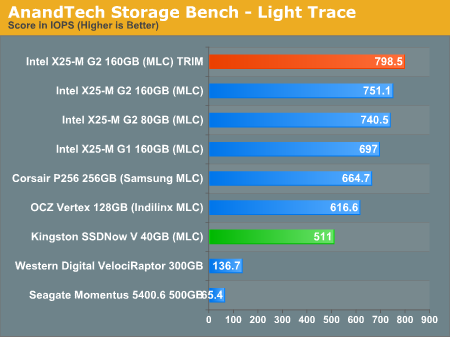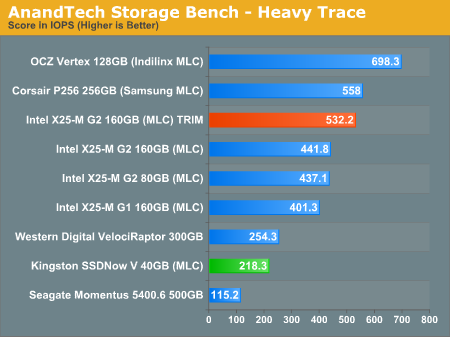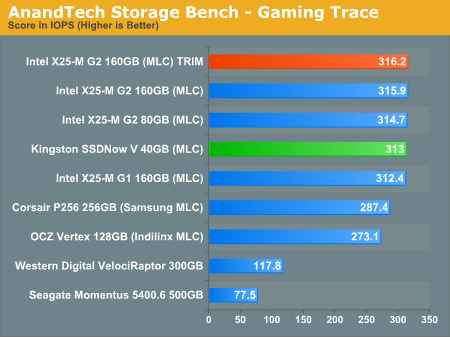The SSD Improv: Intel & Indilinx get TRIM, Kingston Brings Intel Down to $115
by Anand Lal Shimpi on November 17, 2009 7:00 PM EST- Posted in
- Storage
Introducing the AnandTech Storage Bench - Real World Performance Testing
Finding good, real world, storage benchmarks is next to impossible. The synthetic tests work up to a certain point but you need real world examples. Measuring performance in individual applications often ends up with charts like these where all of the drives perform identically. Benchmark suites like PCMark Vantage are the best we can do, but they are a bit too easy on these drives in my opinion and while representative of a real world environment, they aren’t necessarily representative of all real world environments.
Recently we’ve been able to get our hands on a piece of software that allows us to record all disk activity on a machine and then play it back on any other machine. The point is that we can now model a real world usage scenario without waiting for BAPCo or Futuremark to do it for us.
Our benchmarks debut here, today, and we’re starting with three. We haven’t had time to run all of the SSDs through this new suite so we’ll start with an abridged list.
The first in our new benchmark suite is a light usage case. The Windows 7 system is loaded with Firefox, Office 2007 and Adobe Reader among other applications. With Firefox we browse web pages like Facebook, AnandTech, Digg and other sites. Outlook is also running and we use it to check emails, create and send a message with a PDF attachment. Adobe Reader is used to view some PDFs. Excel 2007 is used to create a spreadsheet, graphs and save the document. The same goes for Word 2007. We open and step through a presentation in PowerPoint 2007 received as an email attachment before saving it to the desktop. Finally we watch a bit of a Firefly episode in Windows Media Player 11.
There’s some level of multitasking going on here but it’s not unreasonable by any means. Generally the application tasks proceed linearly, with the exception of things like web browsing which may happen in between one of the other tasks.
The recording is played back on all of our drives here today. Remember that we’re isolating disk performance, all we’re doing is playing back every single disk access that happened in that ~5 minute period of usage. The light trace is composed of 37,501 reads and 20,268 writes. Over 30% of the IOs are 4KB, 11% are 16KB, 22% are 32KB and approximately 13% are 64KB in size. Less than 30% of the operations are absolutely sequential in nature. Average queue depth is 6.09 IOs.
The performance results are reported in I/O Operations per Second (IOPS):

The hard drives set the minimum level of expectations here, the VelociRaptor only manages 137 IOPS. The fastest SSD is the X25-M G2 with the TRIM firmware installed at nearly 800 IOPS. The improvement over the older firmware is 6.25% thanks to the higher sequential write speed. The G2 is a bit faster than the G1 here, but what’s most interesting is how well the competing SSDs do.
Corsair’s P256 based on the Samsung RBX controller is very close to the performance of Intel’s X25-M G1 at 664 IOPS. It even outperforms the Indilinx MLC based OCZ Vertex by around 8%.
The Kingston 40GB drive is hampered by its small amount of free space. The actual benchmark takes up around 33GB of space, leaving very little breathing room for the baby SSD. That being said, the hopefully $85 bugger is nearly 4x the speed of a VelociRaptor.
If there’s a light usage case there’s bound to be a heavy one. In this test we have Microsoft Security Essentials running in the background with real time virus scanning enabled. We also perform a quick scan in the middle of the test. Firefox, Outlook, Excel, Word and Powerpoint are all used the same as they were in the light test. We add Photoshop CS4 to the mix, opening a bunch of 12MP images, editing them, then saving them as highly compressed JPGs for web publishing. Windows 7’s picture viewer is used to view a bunch of pictures on the hard drive. We use 7-zip to create and extract .7z archives. Downloading is also prominently featured in our heavy test; we download large files from the Internet during portions of the benchmark, as well as use uTorrent to grab a couple of torrents. Some of the applications in use are installed during the benchmark, Windows updates are also installed. Towards the end of the test we launch World of Warcraft, play for a few minutes, then delete the folder. This test also takes into account all of the disk accesses that happen while the OS is booting.
The benchmark is 22 minutes long and it consists of 128,895 read operations and 72,411 write operations. Roughly 44% of all IOs were sequential. Approximately 30% of all accesses were 4KB in size, 12% were 16KB in size, 14% were 32KB and 20% were 64KB. Average queue depth was 3.59.

While I appreciate that Intel improved sequential write speed a bit in the 160GB G2 drives, the heavy trace results show us that it’s not enough. The improvement to the 160GB G2 is tremendous, over 20%. But that only brings the 160GB G2 up to the performance of the Corsair P256 (Samsung RBX). The real winner here is the Indilinx based OCZ Vertex. At nearly 700 IOPS it has the right balance of random and sequential read/write speed for our heavy usage scenario. To quote from the Relapse:
“When I started writing this article I took a big step. I felt that Indilinx drives had reached the point that their performance was good enough to be considered an Intel alternative. I backed up my X25-M, pulled it out, and swapped in an OCZ Vertex drive - into my personal work system. I've been using it ever since and I must admit, I am happy. Indilinx has done it, these drives are fast, reliable (provided that you don't upgrade to the latest firmware without waiting a while) and are good enough.”
This is more than good enough, this is faster than Intel.
Unfortunately Intel has assured me that there’s no additional write speed left on the table for the X25-M G2. We’ll have to wait for the G3 next year to see that addressed.
Kingston’s very low sequential write speed hurts it the most here, the drive actually delivers performance lower than that of a VelociRaptor (although not by much). To be honest, this is a bit of an unfair test for the 40GB drive. It’s far too intense for what would ultimately be an apps/OS drive, but it does highlight the 40GB drive's weakpoints.
Our final test focuses on actual gameplay in four 3D games: World of Warcraft, Batman: Arkham Asylum, FarCry 2 and Risen, in that order. The games are launched and played, altogether for a total of just under 30 minutes. The benchmark measures game load time, level load time, disk accesses from save games and normal data streaming during gameplay.
The gaming trace is made up of 75,206 read operations and only 4,592 write operations. Only 20% of the accesses are 4KB in size, nearly 40% are 64KB and 20% are 32KB. A whopping 69% of the IOs are sequential, meaning this is predominantly a sequential read benchmark. The average queue depth is 7.76 IOs.

The gaming test is almost entirely reads and thus the Intel drives have no weaknesses. The G2s, G1s, TRIM or not, all perform about the same here. They’re about 10% faster than Samsung and 15% faster than Indilinx. Even the 40GB Kingston does just as well here.










162 Comments
View All Comments
Voo - Tuesday, October 27, 2009 - link
Ok I was a bit surprised and tried it myself with my 160gb Intel G2 (no firmware update yet)Copy 10gb file onto drive, MSE full scan and extracting a 4gb file with 7z while the usual stuff (FF, PS, eclipse and winamp) running in the backgorund and I got a maximum QD of under 8, which is higher than I expected it to be, but still far away from a QD of 16.
And when doing more multitasking stuff I'd probably tax the rest of the system more than the SSD so at least for my usual behavior a QD >8 is unrealistic, but I see your point.
There are probably some people who could get a QD of 10-12 in a normal workload, so that could be interesting for them :)
GullLars - Wednesday, October 28, 2009 - link
There is a big difference between average queue and queue during operations. The IO queues are relatively low for all the background operation the OS does, and sequensial read/write, but when you do things like open administrative tools, open a program, or install something, you will se queue spikes of easily 50-60.After i commented this article i had a discussion with some other benchmarkers, and we found that normal use generates IO queue spikes almost whenever you interact with the OS. It doesn't take much effort to generate a queue above 100. Running a couple of virus scans on folders of small files while installing a program and opening a folder with lots of pictures will get you a massive queue.
NeBlackCat - Tuesday, October 27, 2009 - link
Nice work again Anand - I just don't bother reading SSD reviews/features on other sites any more.HOWEVER...
Many people reading this will be developers wondering which controller best favours typical development activities, eg. checking out and compiling large projects. It's a hard one to guess - lots of random reading, sequential reading, random writing (temp files) and sequential writing (output files).
So how about a "typical developer" benchmark of, say, compiling the Linux kernel while concurrently encoding some H.264, grepping all the sources for a string, and watching some por..er, I mean, youtube.
Has anyone else evaluated the best SSD type for s/w development?
clarkn0va - Wednesday, October 28, 2009 - link
Not a reply to your question, but I've taken on the habit of mounting my temp files to a ramdisk. Besides the speed improvement, this should help to reduce unnecessary write cycles to the SSD. Similarly, I run without swap (or page file), RAM being as affordable as it is.lamo - Tuesday, October 27, 2009 - link
TRIM support aside, I wonder how would a pair of $85 Kingston drives in a RAID 0 striped array compare against a $225 X-25M dollar/performance-wise.cosminliteanu - Monday, October 26, 2009 - link
So - "Your best bet is to install Windows 7 with your I/O controller in AHCI mode (for Intel chipsets)" this means you set in BIOS sata controller as AHCI not as IDE ?????Or just leave as IDE and after Win7 install, update intel storage driver as normal...? which is the best solution?
LuMax - Monday, October 26, 2009 - link
Can I use Intel IMSM RAID on just the data storage drives in my PC and retain TRIM functionality on the W7 Pro OS (X-25M G2) SSD?My new PC build plan was to use a single 80GB G2 for the OS and programs and two 2TB HDDs in a RAID1 array for my data/photo/video/music storage. Although I read the relevant part of this article 3 times I am still not certain if this is doable. Yes/No?
LuMax - Tuesday, October 27, 2009 - link
I heard back from Intel today:"Thank you for contacting Intel Technical Support.
I understand your question about the Intel(R) Matrix Storage Manager and the SSD. Since the drives you will be using in RAID are non-solid state disks, and the SSD you will be using will not be part of the RAID, there should not be any problem with TRIM."
somedude1234 - Tuesday, October 27, 2009 - link
I would not expect this to be possible. It sounds like you have 3 drives hanging off of the same SATA controller. You want 2 of them in RAID 1 using the IMSM driver, and one of them using the MS driver.In my experience it would be impossible to get Windows to load 2 different drivers for different ports on the same controller.
Even if they were physically independent but identical controllers (for example if you had 2 identical SAS cards plugged into the same system), as soon as you update the driver on one controller, a reboot results in all instances of that controller using the updated driver.
DoveOfTheSouth - Monday, October 26, 2009 - link
I'd like to know this too.I'm considering a similar set-up (SSD for systems drive, RAID for data storage HDD) - seems best of both worlds.